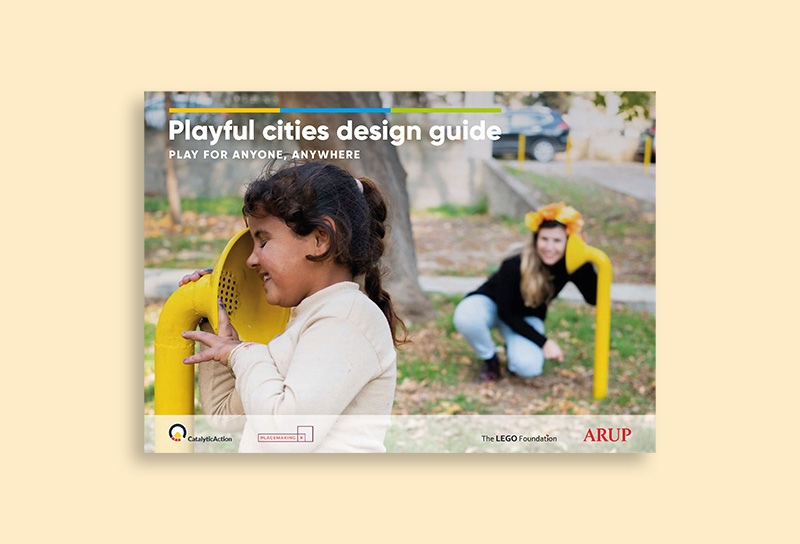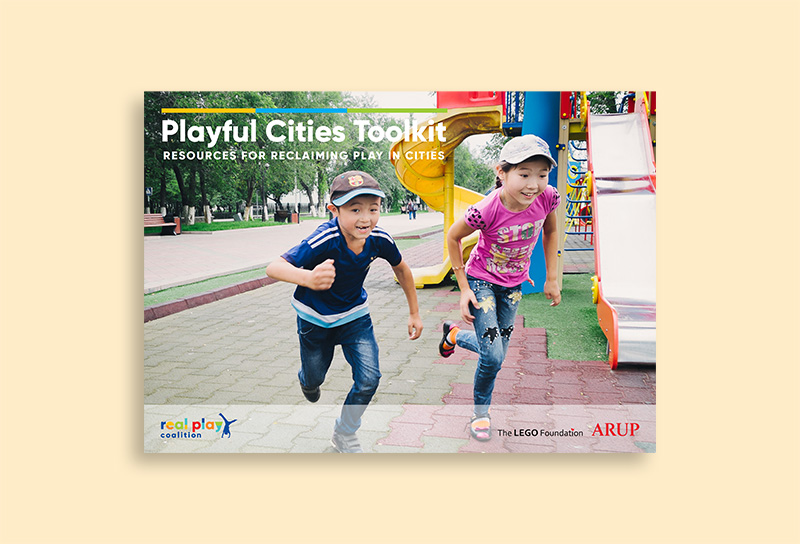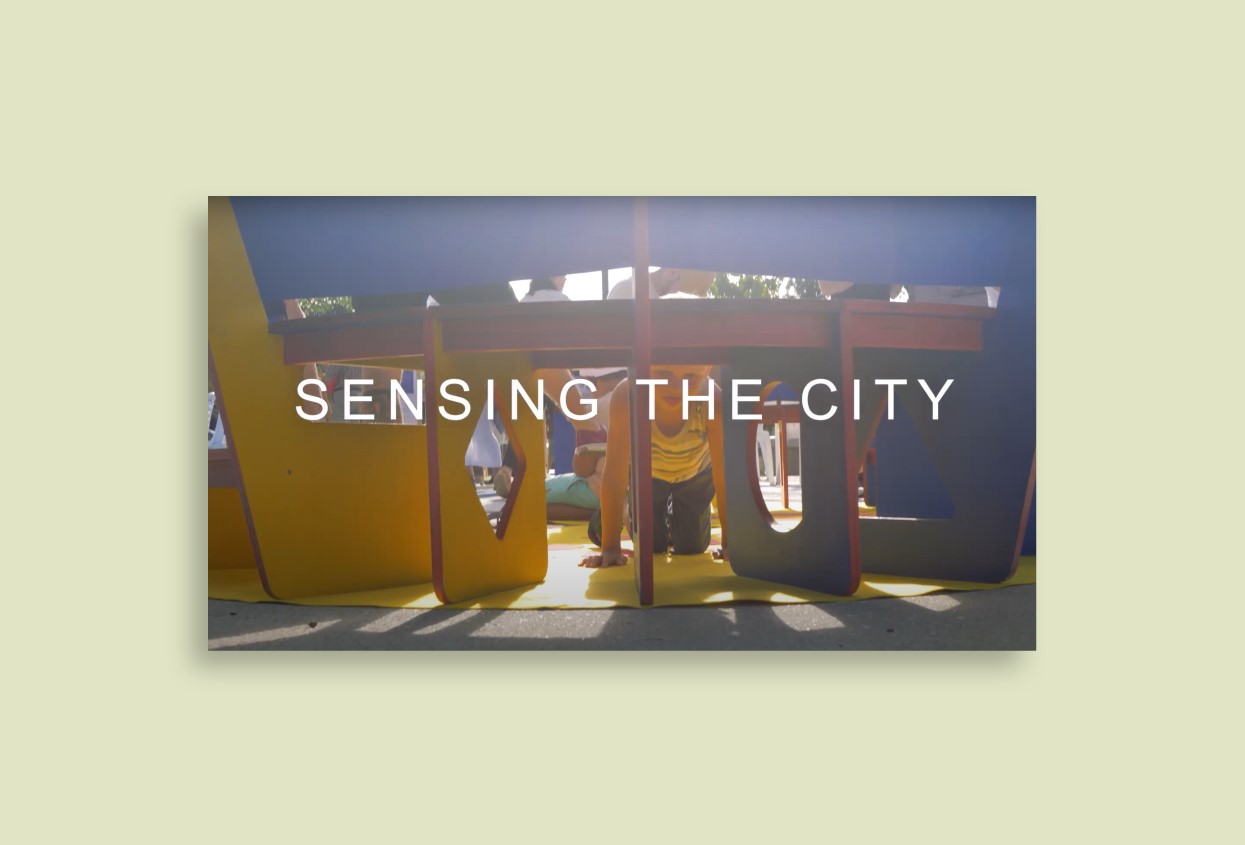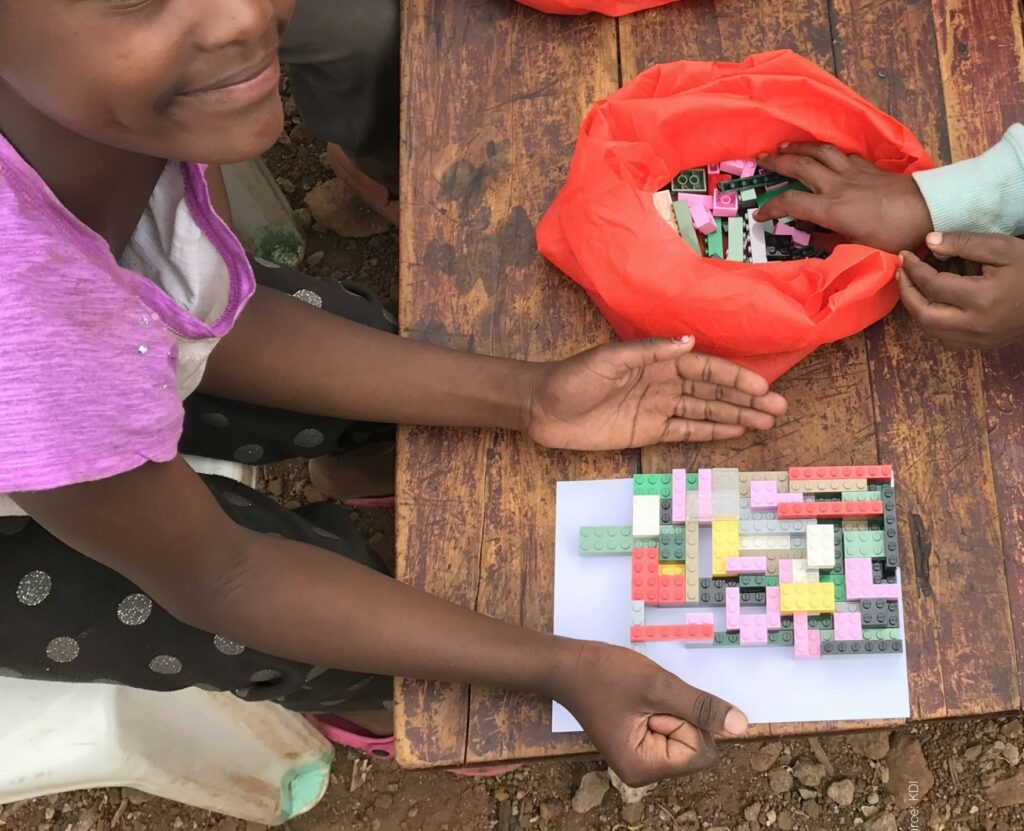
Overview
Location:
Kibera, Nairobi, Kenya
Organisation:
Kounkuey Design Initiative (KDI)
Partner organisations:
Local communities in Kibera; ARUP; Swedish Research Council; Bernard Van Leer Foundation
Year:
2020-2022
Scale of proximity:
Household; Neighbourhood; City
Target beneficiaries:
Children 0-5; Caregivers
Encouraging children to reimagine public spaces through interactive design
Children are often the least served by public infrastructure and most affected by issues such as climate risk, poor sanitation, and lack of safe spaces for play. Kounkuey Design Initiative (KDI) engages children to reimagine the public realm through a range of fun and interactive design activities, as well as consulting with families to ensure their needs are met. In 2020, KDI developed a community mixed-use public space in an informal neighbourhood of Nairobi called Kibera. Operated by a youth group, the space benefits the surrounding community by providing basic amenities such as a hall for hire, public space seating and shade structures, water tanks, a playground, gardens, a laundry pad, and a sanitation block.
The Kounkuey Design Initiative is a non-profit design and community development organisation registered in Nairobi, Kenya; Stockholm, Sweden; and California, USA. KDI partners with under-resourced communities to advance equity and activate the unrealized potential in neighborhoods and cities. This mission is accomplished through advocacy, research, planning, and built works. KDI works with residents to realize their visions for healthier neighborhoods through the tools of participatory urban design and planning. In Nairobi, KDI has been co-designing with residents there since 2006, and in 2020, partnered with Arup and BvL to pilot the application of the Proximity of Care Design Guide invulnerable urban contexts. Arup and KDI have been longstanding partners in Kenya and the US, working together on projects like the Anwa Junior Academy, Kibera Public Space Project 05 bridge with the Nairobi County, and the North Shore park in Eastern Coachella Valley.
Understanding design challenges and opportunities by co-creating public spaces
We began our project by using the Proximity of Change framework to identify a range of challenges and opportunities in Kibera, particularly in the areas of Stimulation, ensuring playful and engaging environments for young children, and Protection, ensuring children have a safe space for play and growth.
Through findings from our field research and a co-creation process, it became apparent that any design and planning interventions recommended for Kibera needed to be based on emergent principles that cut across all the Proximity of Care dimensions in order to be successful. This nicely highlights the importance of taking a comprehensive and integrated approach to addressing complex issues in vulnerable urban settlements.
Through the “understand” phase, we found that Makina, a village in the northwest of Kibera, was once a marshy swampy area prone to regular flooding despite its distance from any river or stream. Frequent flooding exposes young children and residents to contaminated stagnant water, leading to health problems. There are no safe spaces for children to play nearby, so they play on the streets, which are busy with motorbikes and hand-pulled carts, posing risks to their safety. The market built west of the neighbourhood discharges waste into an open channel, putting children, expectant mothers, and caregivers at risk of infections and diseases. The village however has a central area that was once a decommissioned pit latrine. The area was jointly reclaimed by the youth and elders and turned into an open space for the community.
While the area has many challenges, the key opportunity was the central open space in Makina which was providing a much-needed respite for the residents, with the capacity to address many of the surrounding challenges. This space therefore became the focus for the design intervention stage.
Designing safe public spaces for the community to gather and children to play
The co-design process involved the participation of residents, both young and elderly in Makina. A specific workshop was organised for children, featuring engagement tools such as Lego-type bricks by Soho, sketching, colouring, and storytelling, in order to explore the configuration of the identified public space and its relation to the surrounding neighbourhood. Through these workshops, a number of design features emerged:
- Ensuring strategic sitting spaces along the streets are pulled back to the edge and give a vantage surveillance view over the public space.
- Covering over open drains at strategic/ desired crossing points. Further ensuring the depth and breadth of uncovered channels pose minimal trip hazard to children, caregivers and especially the elderly.
- Provision of toilets and showers for communal use on the public space are segregated to serve men and women separately.
- Kids’ play zone located strategically buffered away from the streets to discourage younger children from playing in the risky high traffic paths used by motorbikes and adults.
- Womens toilet and shower cubicles are bigger than mens with outward opening doors for more space and to cater for use by more than one person (when the caregivers tend to their children).
- Strategically placed hand washing for residents ensuring hygiene conditions are within the facility.
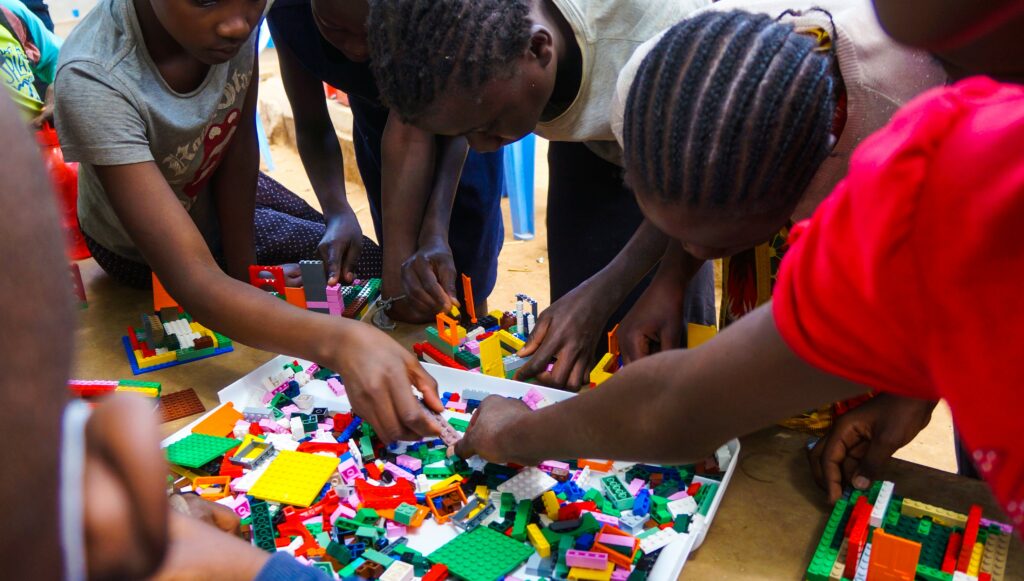
Children participating in co-design workshop using Lego-type bricks by Soho..
Urban design that supports children and caregivers can benefit the whole community
Through partnership between VUMA and KDI the construction of Kibera Public Space Project (KPSP) 11 began in 2019 and was completed in 2021.
One of the key features of the public space was the gender-segregated sanitation facilities, which are equipped to cater to the specific needs of each gender. Overall, the new community space has been viewed as an important asset to the Kibera community, providing much-needed amenities and a safe, comfortable space for people of all ages to gather and enjoy.
Monitoring and evaluation of the project is crucial to determine its long-term success and to inform future interventions. Key indicators could include:
- Improvement in the health and well-being of residents, particularly children and caregivers, as a result of improved sanitation facilities and reduced exposure to contaminated water and environments.
- Reduction in the risk of flooding in the area, which could have positive impacts on health and safety as well as on economic opportunities.
- Increased social cohesion and community engagement, as evidenced by participation in community events and activities hosted in the public space.
- Increased economic opportunities and financial stability for local residents, particularly those involved in operating and maintaining the amenities and facilities.
By monitoring these aspects, the project team can gather data and feedback to continuously improve and adapt the public space and its amenities to better meet the needs of the community, as well as to make a strong case for future investment in similar initiatives.
Building upon this success, the next steps for our project could involve the following upgrades targeting wider proximities of scale:
- Increasing plant covers to provide human comfort to encourage walkability.
- Dedicating specialised maternal care clinic with the neighbourhoods within a 15 minutes proximity.
- Providing bus stops to increase connectivity and accessibility to distant amenities.
- Decongesting buildings and street features at eyesight level to ensure clear vistas through alleyways and paths to improve accessibility and surveillance especially in densely built neighbourhoods.
- Providing adequate and visible crossings on open motorised roads.
- Providing street furniture to activate streets and increase surveillance.
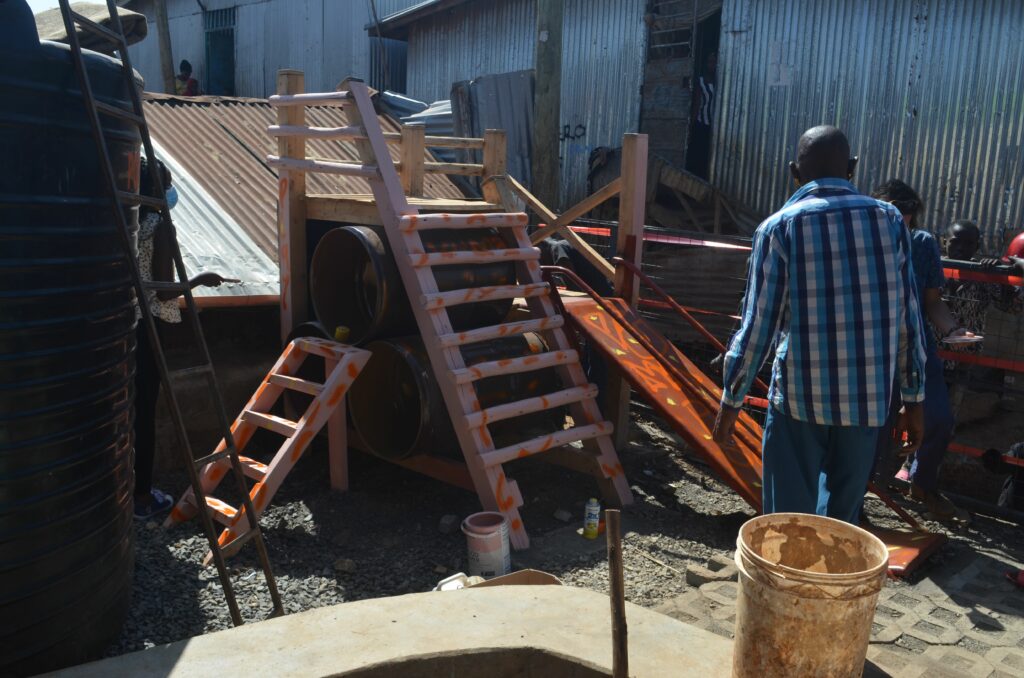
Playground under construction at VUMA.
Advice for implementing a child-friendly project
Developing and implementing design solutions to support children and caregivers can be a complex process that involves careful planning and consideration of a variety of factors:
- “It takes a village to raise a child”. Neighbourhood planning and design should capitalise on this social fabric to strengthen the support needed by caregivers to nurture children at all stages of development.
- Spaces should offer responsive, stimulating environments that engage young children’s minds to explore, learn, and grow. Ongoing training and professional development opportunities for teachers on active learning and play-based methodologies are crucial.
- The perspective and priorities of children, their caregivers, and pregnant women are invaluable for finding sustainable and meaningful solutions to the challenges faced in early child development.
- The process of involving end-users in spaces and places designed for their use gives a sense of ownership and stewardship.
- Designated and appropriate spaces (inclusive, accessible, clean, and safe) are not in conflict with flexible approaches to design and planning. Design and planning should incorporate the social, emotional, and physical needs of children, their caregivers, and pregnant women, giving them more freedom, comfort, and safety even within their homes and neighbourhoods.
- There are already existing systems of care and support in vulnerable neighbourhoods that should be leveraged in the design and planning process. Engaging with these systems can also help identify gaps in services and resources.
- Capacity building and partnerships are crucial for sustainability. Partnerships with local organisations and stakeholders can help build capacity and ensure that interventions are sustainable and impactful. The focus should be on building local capacity and promoting ownership of the interventions.
Links and sources
See KDI’s Proximity of Care site assessment of Kibera: https://www.proximityofcare.com/proximity-of-care-site-assessment-report-kibera-kenya/
View further details of the Kibera project on KDI’s website: https://www.kounkuey.org/projects/kibera_public_space_project_network
Watch a video of KDI’s latest project in Kibera called Playbaze: https://vimeo.com/747793558/eb53d04178

